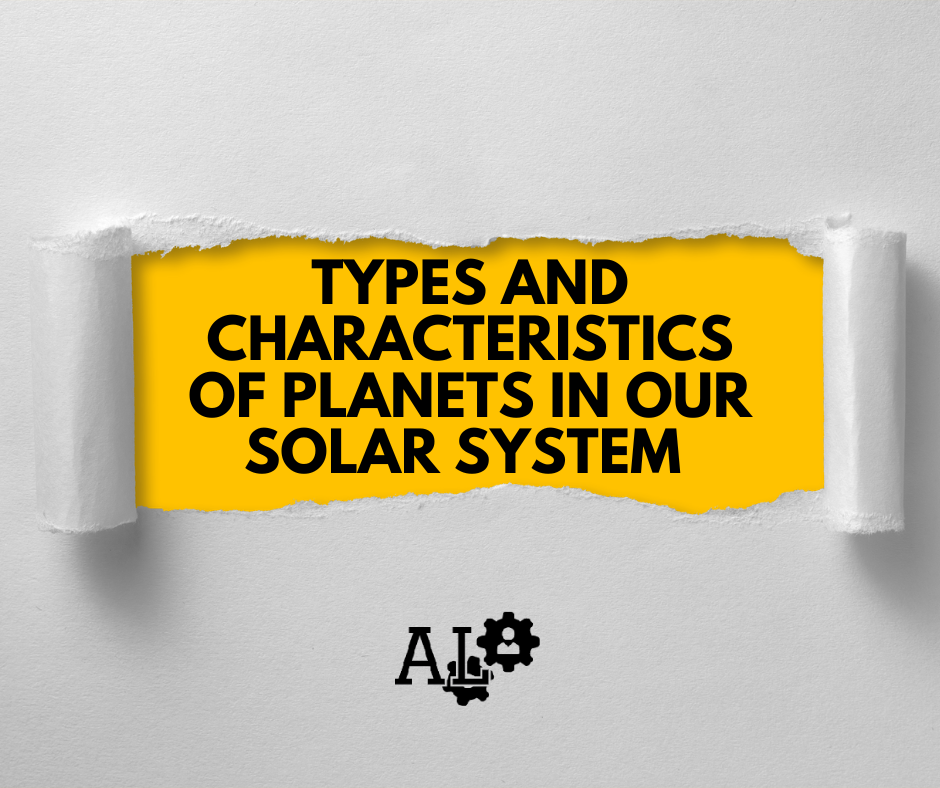Types and Characteristics of Planets in Our Solar System

Our Solar System is a fascinating collection of worlds, each with its own personality, makeup, and mysteries. Astronomers classify planets into several categories based on their composition, location, and unique features. Understanding these classifications helps us appreciate the incredible diversity of our cosmic neighborhood.
Terrestrial Planets




The terrestrial planets—Mercury, Venus, Earth, and Mars—are the rocky members of the Solar System. They are characterized by solid surfaces, relatively small sizes compared to gas giants, and a composition primarily made up of metals and silicate rocks. These planets lie closest to the Sun, making them part of the “inner planets” group.
Mercury is the smallest and closest to the Sun, experiencing extreme temperatures due to its thin atmosphere. Venus, often called Earth’s “twin” due to its similar size, is enveloped in a dense atmosphere of carbon dioxide, creating a runaway greenhouse effect that makes it the hottest planet. Earth is unique for supporting life, with abundant water and a balanced atmosphere rich in nitrogen and oxygen. Mars, the “Red Planet,” intrigues scientists with its iron oxide surface, ancient riverbeds, and potential for past microbial life.
Terrestrial planets typically have few moons—Earth has one, Mars has two small ones, and Mercury and Venus have none. They also lack the massive ring systems seen in other planetary types. Their solid nature makes them easier for landers and rovers to explore, giving us rich data about planetary geology and evolution.
Gas Giants


Gas giants are massive planets composed mostly of hydrogen and helium, with no well-defined solid surface. In our Solar System, Jupiter and Saturn are the primary representatives of this category. These planets are located beyond the asteroid belt, making them part of the “outer planets.”
Jupiter is the largest planet, so massive it could fit all the other planets inside it. Its most iconic feature is the Great Red Spot—a gigantic storm that has been raging for centuries. It has a strong magnetic field and more than 90 known moons, including the intriguing Europa, which may harbor a subsurface ocean. Saturn, famous for its majestic ring system, is slightly smaller than Jupiter but still enormous. Its rings are made of ice particles, rock debris, and dust, and it also boasts a diverse collection of moons, such as Titan, which has lakes of liquid methane.
The atmospheres of gas giants are thick and turbulent, with powerful winds and storms. Their immense size and gravity play a key role in shaping the Solar System’s structure, influencing the orbits of asteroids and comets. Because they lack a true surface, spacecraft that venture into their atmospheres are eventually crushed by the extreme pressure and heat.
Ice Giants


While often grouped with gas giants, Uranus and Neptune are better classified as “ice giants” due to their distinct composition. They contain more elements like water, ammonia, and methane—known as “ices” in planetary science—alongside hydrogen and helium. This gives them a different internal structure and appearance.
Uranus is unique for its extreme axial tilt of about 98 degrees, meaning it essentially rolls around the Sun on its side. This unusual tilt causes extreme seasonal variations that last over 20 years each. Its pale blue-green color comes from methane in the atmosphere, which absorbs red light and reflects blue. Neptune, the farthest planet from the Sun, is a deep blue world known for its intense winds, the fastest in the Solar System, reaching speeds over 2,000 km/h. It also features dark storm systems similar to Jupiter’s Great Red Spot.
Ice giants have faint ring systems and a smaller number of moons compared to gas giants, but their satellites are fascinating in their own right. For example, Neptune’s largest moon, Triton, has geysers that shoot nitrogen gas into space. Both Uranus and Neptune are colder than other planets, with temperatures plunging far below freezing, yet their dynamic atmospheres and mysterious interiors make them key targets for future exploration.
Dwarf Planets


Dwarf planets are celestial bodies that orbit the Sun and are spherical in shape but have not cleared their orbital path of other debris. Pluto, Eris, Haumea, Makemake, and Ceres are the most recognized members of this category. They are smaller than the eight major planets but still hold significant scientific value.
Pluto, once considered the ninth planet, was reclassified as a dwarf planet in 2006 by the International Astronomical Union (IAU). It has a thin atmosphere that freezes and collapses onto the surface when it moves farther from the Sun in its elliptical orbit. Ceres, located in the asteroid belt, is the only dwarf planet in the inner Solar System and contains large amounts of water ice beneath its surface. Eris is slightly smaller than Pluto but more massive, located in the distant scattered disk region.
Dwarf planets often have unusual shapes, tilted orbits, and unique geological features. Some have moons—Pluto’s moon Charon is nearly half its size. These small worlds offer clues about the early Solar System, as they are thought to be remnants from the planet formation process. Studying them can help scientists better understand how planets evolve and why some bodies grew large while others remained small.








